#Lecanora
Text



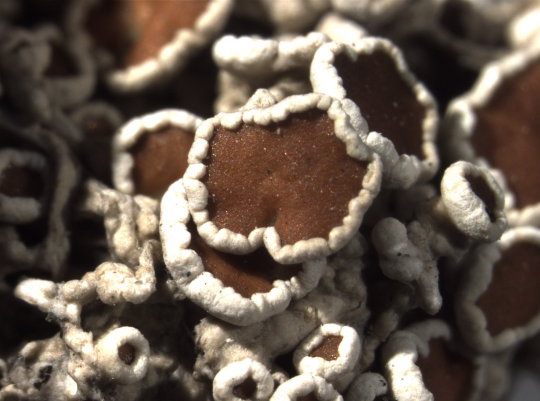



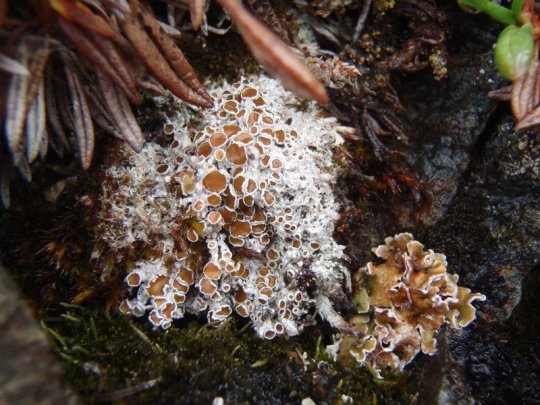
Lecanora epibryon
Mossbane rim lichen, brown-eyed rim lichen
This crustose lichen has a pale white-gray, areolate and warty thallus. It has lecanorine (plate-shaped) apothecia which have a narrow base, a thick margin, and a reddish-brown to dark-brown disc. L. epibryon grows on soil and moss in arctic-alpine habitats.
images: source | source | source
info: source | source
#lichen#lichens#lichenology#lichenologist#mycology#ecology#biology#bryology#botany#symbiosis#symbiotic organisms#algae#Lecanora epibryon#Lecanora#I'm lichen it#lichen a day#daily lichen post#trypo#trypophobia#lichen subscribe
45 notes
·
View notes
Photo



Trentepohlia umbrina, high up in the Mt. airy valley black walnut, Cincinnati, Ohio.
I see three pretty common lichens on this tree but I was not actually trying to photograph any of these despite getting some good shots of one Lecanora hybocarpa complex lichen. aka bumpy rim lichen. Which I actually wanted to use as scale for the size of what I really wanted to take pics of.
Instead I was trying to photograph this beautiful red streak because I feel like often it is over looked and under appreciated from a botanical and mycological perspective, often even assumed to be part of woody material on red oaks as cork or lenticil tissue.
There is a niche group of semi complex crack species and exposed surface species of filimentous algae, actinomycetes, and cyanobacteria that make up a good portion of tree bark biota that we don’t often get taught about despite many of them being directly associated as a functional group(photobiont) of many lichen species. In this case, subaerial algae is the noted or deamed group type, this one on Black Walnut bark high up in the canopy is a filimentous chlorophyte...
https://www.researchgate.net/figure/Examples-of-subaerial-habitats-and-algae-on-and-in-plants-A-Thin-film-of-green-algae_fig15_280577788
specifically the carotenoid rich Trentepohlia spp., Most species of Trentepohlia species are generalistic, even pollip clustering or forming long elongated hairs that are free standing and grow on rocks and trees freely depending on moisture and mineral contents. Some are directly associated with parasitism or within’ lichen as a mutualist coevolved as photobiont.
Most species are pretty dang hard to Identify, resulting in utilizing microscopy or sequencing in order to resolve a taxa delineation.
Here, pictured above, is a very small species of bark dwelling caespitose (mat forming) relatively as prostrate as possible( growing non erect and almost adhering to the surface.) The good ol’ fashion algae is easy to get a sample of and put under a scope free floating in water, once done look at the filimentous grouping, linear psuedoseptae with elongated cells in conjunction with the roles of plasmodesmata for cytoplasmic streaming is not what I saw, instead I got adjacent rounded blobs forming the filamentous line with most of the pigment filing the cells. So matted dark red tree balls is what I viewed, Trentepohilia umbrina. The interesting thing is that this species is very small and while preferring exposure/barren niche like many Trentepohilia spp. do; we see this species in shaded cracks and crevices more than in zones of full exposure. Hence why umbrina may have been selected as epithet. ( within the shadows)
The most common species and easiest to ID are:
Trentepohlia abietina ( a small polip cluster forming tree only species) often associated with elongated cell structure. (https://www.jstor.org/stable/44841106)
Trentepohlia aurea Orange rock hair (the only species with an english common name that I am aware of) most of the other species only seem to have dutch, norwegian , russian, siberian, or native american first nation (inuit, metis, Musqueam, Squamish, and Tsleil-Waututh) names. This species is huge and easy to see the hairy polip clusters.
Trentepohlia jolithus , a true nordic and beringian species limited to high volcanic regions in the northern hemisphere and very bright and prostrate forming dense mats on rocks appearing as a film
Trentepohlia umbrina , or as I call it, matted on bark dark red tree balls clustered as a filamentous line, https://www.inaturalist.org/taxa/410587-Trentepohlia-umbrina/browse_photos This is what you see under obs scope, If you
Other common species but with no accessibility as far as ID delineation are these:
Trentepohlia flava , a coastal salt mist generalist species often found along the western coast of North America on rocks but also commonly found in europe near sea side areas in the north, while this doesn’t fully explain it’s locality niche or fix any range maps because we really don’t know if it has a cosmopolitain range or not and already a var. complex has formed along with range divisions.
https://www.proquest.com/openview/7f3a8e73a75fb8212470443aa189452c/1?pq-origsite=gscholar&cbl=37953.
The rest of these species in the genus are very inaccessible without ITIS or a lab to access.
#Trentepohlia umbrina#trentepohlia#botany#plantblr#mycology#lichenology#dendrology#physiology#algae#kawaii#lichen#lecanora#lecanora hybocarpa#umbrina#red stuff on my tree#ohio#juglans nigra#juglans
44 notes
·
View notes
Text


glow in the dark lichens anyone?
#quietdraws#lichen#cladonia#pixie cup lichen#lecanora#parmelia#nature art#these were just really fun to make lol
2 notes
·
View notes
Text
Lecanora and Syntrichia.... textured and pokeable


2 notes
·
View notes
Video
n29_w1150 by Biodiversity Heritage Library
Via Flickr:
The instructive picture book, or, Lessons from the vegetable world Edinburgh :Edmonston & Douglas, 87 Princes Street,1858. biodiversitylibrary.org/page/59644161
#Fruit#Plants#Vegetables#Lloyd Library and Museum#lichen#fungus#alga#moss#fern#grass#palm#orchis#rose#auricuda#clematis#oak#lecanora tartarea#agaricus variabilis#delesseria sanguinea#hypnum revolvens#polypodium vulgare#holcus lanatus#zamia pumila#orchis morio#anacamptis morio#rosa canina#primula auricula#botanical illustration#scientific illustration
0 notes
Text
Alrighty so this is the post on lichen dyes!
this particular bath of lichen dyes was originally started over a year ago scraping a tentatively-ID'd lecanora and/or ochrolechia genus lichen off of a fallen branch (remember, don't gather lichen when it's still growing! it's very slow growing and easy to overharvest)
to start off, this particular type of dye is made through the ammonia-fermentation method, also known as ammonia maceration. No actual bacterial fermentation occurs though. Rather, the compound orcinol (and precursor compound to orcinols) react with ammonia (N2) and oxygen to form the compound orcein (also called orchil/archil) which is what makes the final dye!
this process takes anywhere from 3 weeks to 16+ weeks depending on the lichen species, its constituent acids, the temperature, and the frequency of aeration.
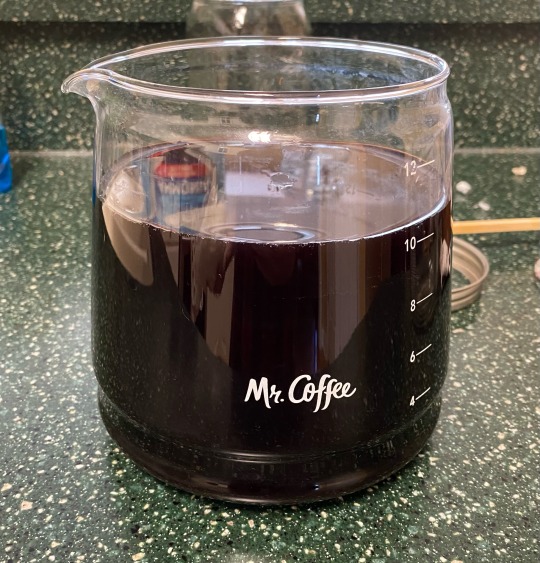
This batch was set aside for several months and neglected a good bit, but it still works. I strained out the crumbled lichens (which i set aside for later) and diluted it 1:4 as instructed by a very good book called Lichen Dyes: The New Source Book by Karen Diadick Casselman. This book is basically omnipresent everywhere you see lichen dyes mentioned, especially the orcein-based dyes. I also used several websites/videos/papers and such that i've hunted down over various internet crawls.
I use an old coffee pot for this as it's both a non-reactive material (glass) and is built to withstand heat. Ironically i also scraped the lichens off the branch using a tool i made out of a metal band from the broken handle of this same coffee pot!

I decided to dye some eri silk cakes that i fluffed up and scoured. these have been very good at absorbing dye in the past so i would hopefully get a good result from them. As lichens are a substantive dye i don't have to put a mordant on them, but i did soak them in an alum solution just before adding them to the dye bath to hopefully maximize dye uptake as well as improve fastness as lichen dyes are also fugitive and can fade in sunlight.
Substantive dyes contain mordants already embedded in them; fugitive dyes are a bit fuzzy to me but my understanding is they end up trapped in the fiber instead of actually bonding to the fiber in a stronger way. Mordants are used to help the dye "bite" onto the fiber better, improving both fastness (the ability of a due to resist fading from sunlight/washing/time) and the brightness of a color. Alum is useful in that it typically doesn't affect the end color of a dye more than simply making it slightly more strong!
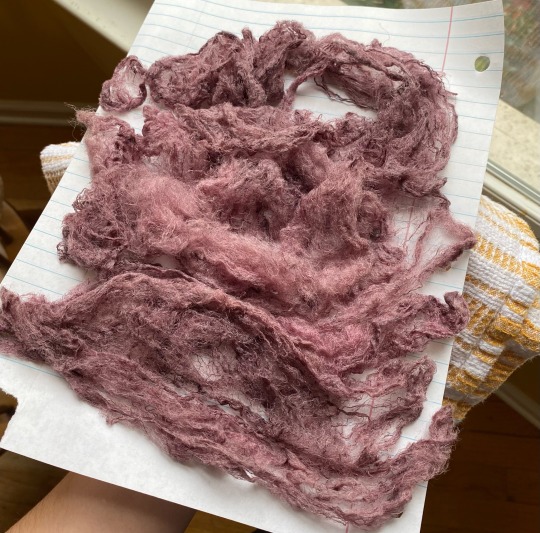
it was pretty successful i'd say! i warmed up the dyebath, added the silk, let it simmer for a few hours, let it cool down overnight, and then warmed it back up the next day for a few hours; then, when it cooled, i took it out, let it dry, then rinsed it, and let it dry a second time. At that point, it was ready for spinning!
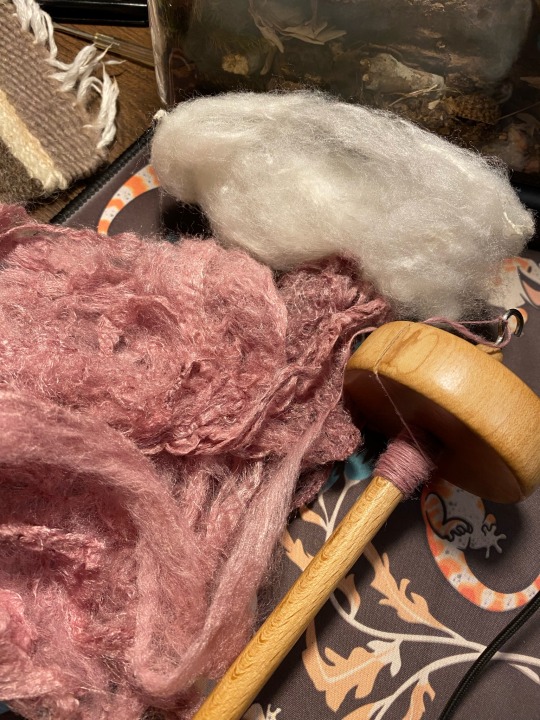
It was a lovely pink color that's not fully captured by the camera like most dyes, and eri silk is lovely because you can spin the clouds directly and easily without carding and make lovely relatively threadlike yarn

this was the first skein i got! i love how shiny the silk is. Some dyes can get really purple or even magenta-like!
next, i had the leftover lichens that i had set aside. They were a crumbly texture and dark black and i dried them out, crushed them up more, set them back in a jar, added more ammonia and water, and did the ammonia fermentation method a second time! this was after reading about the method for making french purple, and while this is definitely a very pale imitation of the method, the double-soak is the key feature here
here it is (on the left); it was already way darker purple than an in-progress lichen dye i had yet to crack open and use

speaking of which, heres a shot of various test lichens i had while working on this, you can see the blue-capped jar that has the second-soaked lichens. the foam will often give a preview of whether or not the dye will be red/purple or not!

Here it is, i forget how long i let it soak but i think it was a bit over a week. i strained the material out, diluted it, and then repeated the same warm/cool/warm/cool/dry/rinse/dry method with more eri silk

And below you can see the difference, it's definitely slight but still cool!

the left is from the original dyebath, the right is the second-soaked one. the first one is more salmon-colored while the second is a tad more blue-purpled!
I'm extremely excited about this, these dyes have such a fascinating history and have multiple historical uses everywhere from florentine orchil to norwegian korkje to scottish cudbear and more, and it was often used in tandem with the roman murex/tyrian purple dyes that come from a mussel. Some folks used the lichens to pre-dye the fabric before dyeing with tyrian purple, both to stretch the expensive tyrian purple and to make the end color more vibrant. It's all such a great topic that's mightily confusing and could take up a post of its own, same with the underlying chemistry of what makes these dyes work in the first place!
Anyways that's all for this post, i have more i'm working on involving actually turning these dyes into paint that i'll hopefully turn into a post on its own soon! I've also got other lichen dyes I'm waiting to get through the ammonia fermentation process that will hopefully give other colors, whenever that may be!
#lichen dyes#ammonia fermentaion#handspinning#natural dyes#eri silk#yarnmaking#fiber arts#vegetable dyes#orcinol#art#orcein#archil#crafts#yarn#silk#drop spindle
604 notes
·
View notes
Text

Aspicilia malmeana (H. Magn.) Ozenda & Clauzade [ITALIC – The Information System on Italian Lichens, Version 7.0, Dept. of Biology, University of Trieste, Trieste]
Bibl.: Adolf Hugo Magnusson, Studies in Species of Lecanora. Mainly the Aspicilia Gibbosa Group, Kungliga Svenska Vetenskapsakademiens Handlingar, Vol. 17, No. 5, Almqvist & Wiksells Boktryckeri, Stockholm, 1939
#graphic design#botany#biology#chemistry#phytochemistry#illustration#lichen#book#adolf hugo magnusson#italic#kungliga svenska vetenskapsakademiens handlingar#1930s
15 notes
·
View notes
Video
Lichen community on douglas fir cone by Richard Droker
Via Flickr:
Hypogymnia physodes, Usnea sp., Parmelia sulcata, Melano..., Lecanora sp., Chrysothrix granulosa micro checks - Buellia (aka Amandinea) punctata
My lichen photos by genus - www.flickr.com/photos/29750062@N06/collections/7215762439... my photos arranged by subject, e.g. mountains - www.flickr.com/photos/29750062@N06/collections
#conicolous#cone#Douglas fir#flickr#lichen#lichens#lichenology#mycology#fungus#fungi#plants#botany#fircone#fir cone#pine cone#forest#forest floor#trees#woods#nature
7 notes
·
View notes
Text

i am doing Science
(Evernia sp/british soldier lichen/reindeer lichen/toadskin lichen/secondary processing if lecanora sp/first processing of lecanora sp)
majority collected from fallen sources or by following the less-than-10% rule in plentiful areas (soldier lichen + toadskin lichen). Never overharvest lichens! they grow very slowly
I'm going after archil/orcein dyes derived from the orcinol and orcinol precursor acids. I wanna make a more in-depth post about it on my crafts and shenanigans sideblog soon
4 notes
·
View notes
Link
0 notes
Photo

English: jpg of Plate CXCVIII of Hooker's Flora Antarctica. Made up of four smaller images of Lichenes. Fig I: Lecanora chrysoleuca Ach. (var); Fig II: Lecanora miniata Ach.; Fig III: Lecanora Babingtoni Hook. fil & Tayl.; Fig IV: Verrucaria umbrina Ach.
0 notes
Text



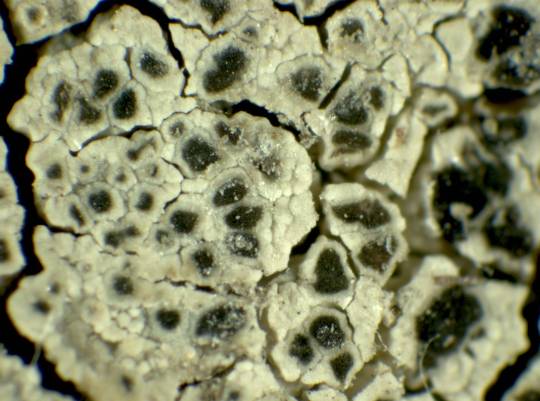






Lecanora intricata
Lichens have a few different ways to reproduce (they're just awesome like that) but most lichen symbioses include an ascomycete fungi, AKA a sac fungi. These fungi create spores in internal sacs known as asci (singular: ascus), and lichenized ascomycetes often house these sacs in their apothecia, or fruiting bodies. So you see those dark spots on the surface of our pal L. intricata here? Those are its apothecia, or its fruiting bodies, from which fungal spores will be ejected to go out and hopefully form their own little lichens someday. Pretty neat, huh? L. intricata is a crustose lichen with a verrucose (wart-like)-areolate (tile-like) thallus. It has a gray-green to yellow-green surface sitting atop a dark prothallus (a layer of fungal hyphae). It should look something like puzzle-pieces on a dark surface. It has blackish-green to brown, irregularly shaped apothecia immersed in the thallus surface. L. intricata grows on silicious rock and occasionally wood in montane, boreal, and arctic habitats.
images: source | source | source | source
info: source | source | source
#lichen#lichens#lichenology#lichenologist#mycology#ecology#biology#fungi#fungus#nature#symbiosis#symbiotic organisms#algae#the natural world#life science#environmental science#natural science#trypo#trypophobia#Lecanora intricata#Lecanora#I'm lichen it#lichen a day#daily lichen post
50 notes
·
View notes
Text
Type fu 4.5.7

Taking into account the strong similarity in terms of combustion system design between Euro 5 and Euro 6 engines, the estimated trends can be considered valid also for Euro 6 vehicles equipped with the same class of engines. Results of the experimental activity proved that HCK-HVO blends give a benefit on both FC and CO2 saving. A specific test procedure based on a sequence of New European Driving Cycle (NEDC) and ARTEMIS cycles on an engine dyno test bed was applied in order to carry out accurate fuel consumption measurements versus fuel quality, so reproducing the fuel effects on FC for long mileage use of the vehicle. The set of fuels comprised three experimental fuels formulated ad hoc by blending HVO and HCK streams, and an EN590-compliant commercial diesel fuel representative of the current market fuel quality. Three fuels have been formulated and tested in a light duty four-cylinder diesel engine, Euro 5 version, equipped with closed loop control of the combustion. The present paper describes the results of a research activity aimed to assess the potential of hydrocracked fossil oil (HCK) and Hydrotreated Vegetable Oil (HVO) blends, as future premium diesel fuels, on fuel consumption (FC) reduction of the modern automotive diesel engines. The experimental results showed that in many cases the observed outcomes were probably attributable to a combination of combustion effects, after-treatment effects, and their control strategy. Low ambient temperature caused an increase of the emissions of studied compounds (with the exception of NH3) with all tested blends. However, HVO-100 resulted in ∼4% lower CO2 emissions than the other fuel tested in all the studied conditions. Overall, the use of different HVO blends and diesel did not lead to fuel related trends on the emissions of the tested vehicles in the laboratory nor on-road. One of the vehicles was also tested using the three HVO blends on-road following a RDE compliant route. The HVO blends used were: Neat HVO (100 vol% HVO), 30 vol% HVO and 7 vol% HVO. pulla group.Regulated and unregulated emissions from two Euro 6b diesel passenger cars tested using three different blends of hydrotreated vegetable oil (HVO), fossil diesel and commercial diesel (B7) were investigated at 23 ☌ and −7 ☌ using the World harmonized Light-duty vehicle Test Procedure at the Vehicle Emission Laboratory of the European Commission Joint Research Centre Ispra, Italy. Note: a boreal to (mainly) Mediterranean species found on exposed siliceous rocks, including pebbles, exceptionally also on limestone in the past it has been frequently confused with other species of the X. Chemistry: medulla with divaricatic acid (major), stenosporic, oxostenosporic acids (minor), and variable amounts of gyrophoric acid. Spot tests: upper cortex K-, C-, KC-, P-, N+ blue green medulla K-, C-, KC- (very rarely KC+ fleeting pink), P. Ascospores 1-celled, hyaline, ellipsoid, 8-11 x 4-7 µm. Asci 8-spored, thick-walled, the apex I+ blue with a wide, divergent axial body, Lecanora-type. Epithecium brown hymenium and hypothecium colourless. Apothecia usually numerous, lecanorine, sessile to stipitate, to 4 mm across, with a brown disc and a smooth thalline margin. Upper cortex paraplectenchymatous, with a pored epicortex, the cell walls with Xanthoparmelia-type lichenan medulla white. Lower surface dark brown to black, moderately to densely rhizinate rhizines simple, to 1.5 mm long. Upper surface brown to dark brown, markedly uneven and rugose thallus centre with dense warts, each with an apical depression, resembling young apothecia (a pycnidium is often present within a wart). Lobes 1-3(-5) mm wide, sublinear to linear-elongate, discrete to imbricate or entangled. Description: Thallus foliose, heteromerous, dorsiventral, adnate to tightly adnate, forming up to 10 cm wide, sometimes coalescing rosettes. Synonyms: Neofuscelia perrugata (Nyl.) Elix Distribution: N - TAA (Giordani & al.

0 notes
Photo
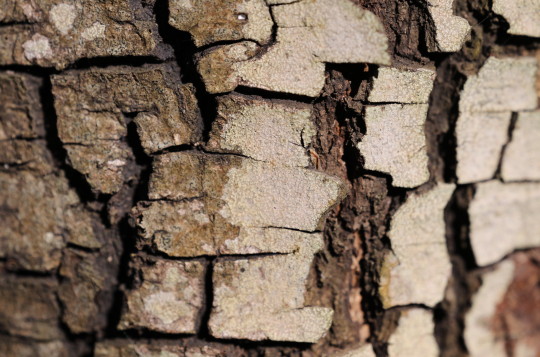
(со страницы Lecanora or perhaps Lecania (had to to take the pic from far away, not 100% sure))
0 notes
Photo




Lichens on a tree trunk - Líquenes em tronco de árvore
Cruz Quebrada/Portugal (29/03/2019)
[Nikon D7100; ∑ 150mm F2.8 EX DG OS HSM APO Macro]
17 notes
·
View notes
Photo
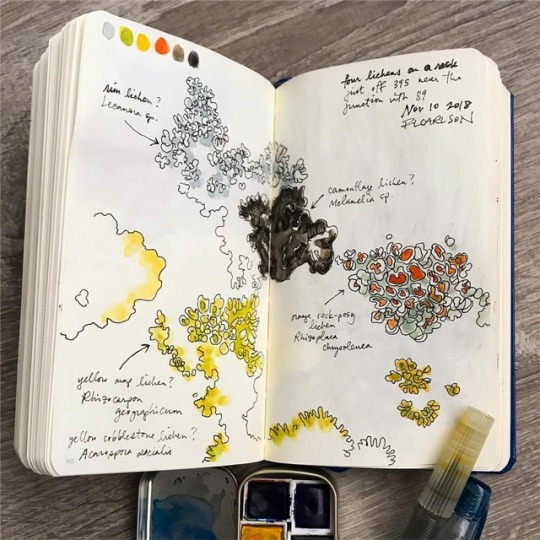
Enjoying lichens in the eastern Sierra. #lichen #yellowcobblestonelichen #acarosporasocialis #rimlichen #lecanora #camouflagelichen #melanelia #orangerockposy #rhizoplacachrysoleuca #travelsketching #sciart #easternsierra https://www.instagram.com/p/BqjQ-Z5BhDF/?utm_source=ig_tumblr_share&igshid=zmym12yhw9jb
#lichen#yellowcobblestonelichen#acarosporasocialis#rimlichen#lecanora#camouflagelichen#melanelia#orangerockposy#rhizoplacachrysoleuca#travelsketching#sciart#easternsierra
14 notes
·
View notes
